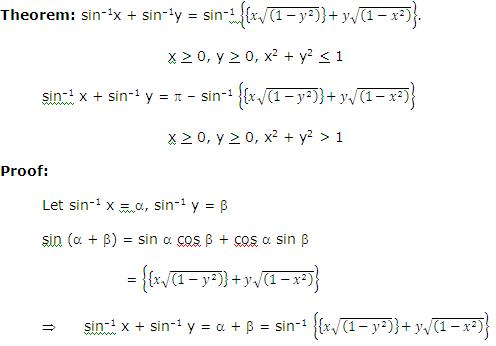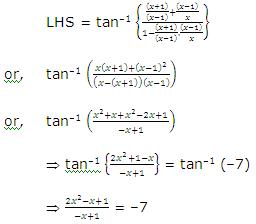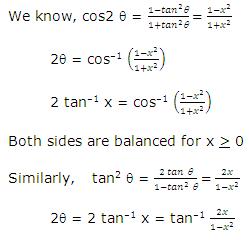Inverse Circular Function (Inverse Trigonometric Functions)
 Inverse of trigonometric ratios exists.
Inverse of trigonometric ratios exists.
We know that y = sin x means y is the value of sine of angle x if we consider domain and co-domain both as set R of a real numbers. Sine ratio as seen from the fig. is many-one into function.
But it is clear that if we restrict the domain to [-π/2,π/2] and range to
[–1, 1], then. Y = sin x is one-one onto and hence it is invertible.
So, y = sin x x ∈ [-π/2,π/2], y ∈ [–1, 1]
⇒ x = sin–1 y y ∈ [–1, 1]. x ∈ [-π/2,π/2]
This value of x is called the principle value, i.e. belonging to [-π/2,π/2] and [-π/2,π/2] range and it is called principal value range.
Note: The smallest numerical angle is called principal value.
In general the inverse circular functions with their domain and range can be tabulated as:

Note: Principal value range of all Inverse Circular function is very important as the function is defined only in this range.
Pause: Odd function are defined as f(–x) = –f(x) and even function as f(–x) = f(x).
The inverse circular functions are defined as below:-
1. sin–1 (–x) = –sin–1 x, –1 < x < 1 Odd function
2. cos–1 (–x) = π –cos–1 x, –1 < x < 1 Neither odd nor even
3. tan–11 (–x) = –tan–1 x, x ∈ R Odd function
4. cot–1 (–x) = π – cot–1 x, x ∈ R Neither odd nor even
5. cosec–1 (–x) = –cosec–1 x, x < –1 or x > 1 Odd function
6. sec–1 (–x) = π –sec–1 x, x < –1 or x > 1 Neither odd nor even
Let us see the proof of any one of the above.
Proof 2:
Let cos-1 (–x) = θ, then cos θ = –x
or, – cos θ = x or cos (π – θ) = x
or, π – θ = cos-1 x or cos-1 (–x) = π –cos-1 x
Similarly we can prove other results.
Caution: Instead of taking cos (π – θ) equal to – cos θ, we could have taken cos (π + θ). We opt for cos (π – θ) because (π – θ) lies in a principal value range i.e. 0 ≤ cos-1 x ≤ π.
Illustration:
Find cot-1 (–1)
Solution:
cot-1 (–1) = π – cot-1 (1)
= π -π/4 [? cot-1 (–x) = π – cot-1 x]
= 3π/4.
Properties of Inverse Circular Function
1. Self adjusting Properties
(a) sin (sin-1 x) = x, x ∈ [–1, 1]
Let sin-1 x = θ, θ &isin (-π/2,π/2) ……… (1)
Then x = sin θ
From (1) putting the value of θ in (2), we get, ……… (2)
sin (sin-1 x) = sin (θ) = x
(b) sin-1 sin x = x, x ∈ [-π/2,π/2].
Let sin x = y, y ∈ [–1, 1] ……… (1)
Then x = sin-1 y ……… (2)
Putting the value of y in (2) from (1), we get,
sin-1 sin x = x
Illustration:
Evaluate sin-1 sin 5, 5 is radian
Solution:
We know sin-1 sin x = x, x ∈ [-π/2,π/2] or x ∈ [–1.57, 1.57]
We can write, 5 = 2 π + 5 – 2 π
sin 5 = sin (2 π + (5 – 2π))
= sin (5 – 2 π), 5 – 2 π ∈ [–1.57, 1.57]
∴ sin-1 sin 5 = sin-1 sin (5 – 2π)
= 5 – 2π
2. Reciprocal Property
sin-1 (1/x) = cosec-1 x, x ≤ –1, or x ≥ 1
let cosec-1 x = θ ⇒ cosec θ, θ ∈ [-π/2,π/2] – {0}
⇒ LHS = sin-1 (1/(cosec θ )) = θ
⇒ sin-1 (sin θ) = θ which is true for above domain of θ
= cosec-1 x = RHS.
Note: cot-1 (1/x) = tan-1 x holds only for x > 0. This is because of principal value range of Inverse function cot and tan are different.
When x < 0, the principal value range is π/2 < cot-1 (1/x) < π, whereas -π/2 < tan-1x< 0. Hence equality will never hold in this case.
cot-1 (-1/2) = tan-1 (–x)
π – cot-1 (1/2) = –tan-1 x
cot-1 (1/2) = π + tan-1 x
Hence cot-1 (1/2) = { tan-1 x, x>0
π+tan-1 x, x< 0
Relation between Inverse Trigonometric Functions
1. sin-1 x + cos-1 x = π/2 x ∈ [–1, 1]
Let sin-1 x = θ, θ ∈ [-π/2,π/2]
⇒ x = sin θ,
⇒ x = cos (π/2-θ ),(π/2-θ ) ∈ [0, π]
⇒ cos-1 x = π/2 – θ
⇒ cos-1 x + sin-1 x = π/2 x ∈ [–1, 1].

We can express any inverse circular function in terms of the other by drawing a right-angled triangle. Thus, if we have to explain tan-1 x in terms of the other, then take the perpendicular of the triangle as x and base as 1. Now, hypotenuse is √(1+x2 )
θ = tan-1 x = cot-1 1/x = sin-1 x/√(1+x2 )=cos-11/√(1+x2 )=cosec-1√(1+x2 )/x= sec-1√(1+x2 )
Illustration:
Prove that sin cot-1 tan cos-1 x = x.
Solution:
Note: In such problems we proceed with the last term of LHS.
Here, LHS = sin cot-1 tan cos-1 x
Let cos-1 x = θ, x = cos θ

∴ tan θ = √(1+x2 )/x
tan cos-1 x= √(1+x2 )/x
(1) Reduces to, sin cot-1 (√(1+x2 )/x) …… (2)
Again let cot-1 √(1+x2 )/x = φ
√(1+x2 )/x = cot φ
∴ sin φ = x

Hence, (2) becomes
sin cot-1 √(1+x2 )/x = x = R.H.S.
Illustration:
Find the value of cos (2 cos-1 x + sin-1 x) at x = 1/5, Where 0 ≤ cos-1 x ≤ π, –&pi/2 ≤ sin-1 x ≤ π/2
Solution:
cos (2 cos-1 x + sin-1 x) = cos (cos-1 x + (cos-1 x + sin-1 x))
= cos (cos-1 x+ π/2)
= –sin cos-1 x …… (1)
Let cos-1 x = θ
⇒ x = cos θ
sin θ = √(1-x2 )
cos-1 x = θ – sin-1 √(1-x2 )
Now, (1) becomes
(2 cos-1 x + sin-1 x) = –sin cos-1 x = –sin-1 √(1-x2 )
= –√(1-x2 ) as –1 ≤ √(1-x2 ) ≤ 1
= – √(1-1/25) at x = 1/5
= – 2/5 √6.

Since x ≥ 0, y ≥ 0 so RHS ∈ (0, π/2) but if x and y are such that
LHS > π/2 then above equation is not valid. So above equation is valid only when
sin-1 x + sin-1 y ≤ π/2
⇒ sin-1 x ≤ π/2 – sin-1 y
⇒ sin-1 x ≤ cos–1 y
taking sine ( ) both sides
sin (sin-1 x) < sin (cos–1 y)
(∴sine is an increasing function in [-π/2,π/2] )
⇒ x < √(1-y2 )
⇒ x2 + y2 < 1
So above relation is valid only when x2 + y2 ≤ 1
Now, if x2 + y2 > 1 then
Let us assume LHS = θ and RHS = φ
Then sin θ = sin φ, which is true only when θ = φ or θ = π – φ
⇒ sin-1 x + sin-1 y = π – sin-1 (x√(1-y2 )+y√(1-x2 )).
Illustration:
If sin-1 x + (sin-1 y + sin-1 z) = π/2
Solution:
Find out x2 + y2 + z2 + 2xyz.
Let sin-1 x = A, sin-1 y = B and sin-1 z = C
⇒ A + B + C = π/2
A + B = π/2 – C.
Let’s operate cos on both sides.
Note: That we have chosen to operate cos because it becomes easier to solve.
cos (A + B0 = cos (π/2 – C)
cos A cos B – sin A sin B = sin C
√((1-x2 ) ) √((1-y2 ) )-xy=z
xy + z = √((1-x2 )(1-y2 ) )
Squaring both sides
x2 y2 + z2 + 2xyz = 1 + x2 y2 – x2 – y2
x2 + y2 + z2 = 2xyz = 1

Hence proved.
Theorem: tan-1 x + tan-1 y = tan-1 {(x + y)/(1 – xy)} if xy < 1
= π –tan-1 (x + y)/(xy – 1) if xy > 1
= π/2 if xy = 1.
Proof:
Let tan-1 x = α so that tan α = x
and tan-1 y = β so that tan β = y
Also let tan-1 ((x+y)/(1-xy)) = γ so that tan γ = (x+y)/(1-xy)
We have then to prove that
α + β = γ
Now tan (α + β) = (tanα +tanβ )/(1-tanα tanβ )=(x+y)/(1-xy) = tan γ
So, the relation is proved
tan-1 x + tan-1 y = tan-1 ((x+y)/(1-xy)) …… (1)
Case I:
When x ≥ 0, y ≥ 0 and xy < 1, (x+y)/(1-xy) is positive
∴ tan-1 [(x+y)/(1-xy)] will be positive angle
Case II: When x ≥ 0, y ≥ 0 and xy > 1, (x+y)/(1-xy) is negative
∴ tan-1 ((x+y)/(1-xy)) will be negative angle.
Hence we add π to make it positive
∴ tan-1 x + tan-1 y = π + tan-1 [(x+y)/(1-xy)].
Case III: When xy = 1, (x+y)/(1-xy) = ∞ then
∴ tan-1 x + tan-1 y = tan-1 ∞ = π/2
Illustration:
Show that the equation
tan–1 {((x+1))/((x-1) )} + tan–1 {((x-1))/x} = tan–1 (–7) has no solution.

⇒ (x–2)2 = 0 ⇒ x = 2
Putting x = 2 in the equation, the equation becomes
tan–1 3 + tan–1 1/2 = tan–1 (–7)
Since x y = 3 . 1/2 > 1
So, tan–1 x + tan–1 y = π + tan–1 ((x+y)/(1-xy))
tan–1 3 + tan–1 1/2 = 3 + tan–1 ((3+1/2)/(1-3/2))
= π + tan–1 (–7) ≠ tan–1 (–7) = R.H.S.
Hence given equation has no roots as x = 2 does not satisfy the given equation.
Illustration:
Solve the equation
tan-1 2x + tan-1 3x = nπ + π/4
Solution:
We know that

So we have the following cases.
Case I:
2x . 3x < 1 ⇒ x2 < 1/6 ⇒ -1/√6 < x < 1/√6
For this
⇒ L.H.S. = tan-1 {(2x+3x)/(1-6x^2 )} = nπ + π/4
Taking tan of both the sides
5x/(1-6x2 ) = tan (nπ + π/4) = 1
⇒ 6x2 + 5x – 1 = 0
⇒ 6x2 + 6x – x – 1 = 0
⇒ (x + 1) (6x – 1) = 0
⇒ x = 1/6 or x = –1
Since –1 ∉ (-1/√6,1/√6)
Hence x = 1/6 is a solution.
Case II:
2x . 3x > 1 ⇒ x ∈ (-∞ ,-1/√6) ∪ (1/√6,∞ )
For this we have
LHS = π – tan-1 (5x/(6x2-1)) = nπ + π/4
⇒ tan (π -tan-1 (5x/(6x2-1)) )=tan(nπ + π/4)
⇒ –tan (tan-1 (5x/(6x2-1)) )=1
= 5x = 1 – 6x2
⇒ 6x2+ 5x – 1 = 0
⇒ (x + 1) (x – 1/6) = 0
⇒ x = –1, x = 1/6, since 1/6 ∉ (-∞ ,-1/√6)∪(1/√6,∞ ).
Hence x = –1 is another solution.
⇒ x = –1, 1/6 are solutions of the given equation.
Theorem:
2 tan-1 x = sin-1 2x/(1+x2 ), where |x| < 1
= cos–1 (1-x2)/(1+x2 ), where x > 0
= tan-1 2x/(1-x2 ), where |x| < 1.
Proof:
Let tan-1 x = θ, then tan θ = x
sin 2 θ = (2 tan θ )/(1+tan2 θ )=2x/(1+x2 )
⇒ 2 θ = sin-1 (2x/(1+x2 ))
⇒ 2 tan-1 x = sin-1 (2x/(1+x2 ))
Both sides are balanced for |x| < 1.
Caution:
Restriction on x is |x|< 1. To verify it suppose the formulae holds good even for x > 1.
Then L.H.S. = 2 tan-1 x
= 2 tan-1 (a no. 1 > 1) [for x > 1]
> π/2 [? tan-1 (>1) > π/4], [for principal values]
R.H.S. = sin–1 2x/(1+x2 ) which lies between -π/2 and π/2 for all values of x, [for principal values]
Thus, we see that for x > 1,
L.H.S. > π/2, whereas R.H.S. ≤ π/2.
Hence two cannot be equal.

Both sides are balanced for |x| < 1.
Note:For |x| > 1
2 tan-1 x = π – sin–1 2x/(1+x2 )
= π – cos–1 (1-x2)/(1+x2 )
= π – tan-1 2x/(1-x2 )
Illustration:
Show that the function y = 2 tan-1 x + sin-1 2x/(1-x2 ) is a constant for x ≥ 1. Find the value of this constant.
Solution:
We know, sin-1 2x/(1+x2 ) = 2 tan-1 x if |x| < 1
Here given x ≥ 1. So if we convert in above condition then we can get solution.
x ≥ 1 can be written as 1/x < 1.
So, for 1/x < 1
sin-1 2x/(1+x2 ) = sin-1 (2/x)/(1/x2 +1) = sin-1 2(1/x)/((1/x)2+1) = 2 tan-1(1/x)
Now, y = 2 tan-1 x + 2 tan-1 (1/x)
= 2 [tan-1 x + cot–1 x]
= π = const.
Illustration:
Show that 2tan-1 1/2 + tan-1 1/7 = tan-1 31/17.
Solution:
We have 2tan-1 1/2 = tan-1 (2-1/2)/(1-1/4) = tan-1 4/3
⇒ 2tan-1 ((4/3+1/7)/(1-4/21)) = tan-1 31/17
Illustration:
Solve 2tan-1(cosx) = tan-1(2cosecx).
Solution:
= tan-1[2cot x cos ecx] = tan-1(2 cosec x) (given)
⇒ cotx = 1 ⇒ x = nπ + π/4.
Illustration:
Show that tan-1 (x/√(a2-x2 )) = sin-1 (x/a), a > 0.
Solution:
Let sin-1 x/a = θ, then x = a sin θ, -π/2 < θ < π/2 as (x ≠ a)
⇒ x/√(a2-x2 )=(a sin θ )/√(a2-a2 sin2 θ ) = tan θ ⇒ tan-1 (x/√(a2-x2 ))
= tan-1 (tanθ) = θ = sin-1(x/a).

To read more, Buy study materials of Trigonometry comprising study notes, revision notes, video lectures, previous year solved questions etc. Also browse for more study materials on Mathematics here.
View courses by askIITians


Design classes One-on-One in your own way with Top IITians/Medical Professionals
Click Here Know More

Complete Self Study Package designed by Industry Leading Experts
Click Here Know More

Live 1-1 coding classes to unleash the Creator in your Child
Click Here Know More

